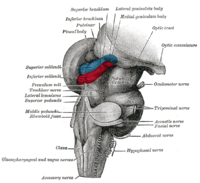
Photo from wikipedia
The cerebellum regulates complex animal behaviors, such as motor control and spatial recognition, through communication with many other brain regions. The major targets of the cerebellar projections are the thalamic… Click to show full abstract
The cerebellum regulates complex animal behaviors, such as motor control and spatial recognition, through communication with many other brain regions. The major targets of the cerebellar projections are the thalamic regions including the ventroanterior nucleus (VA) and ventrolateral nucleus (VL). Another thalamic target is the central lateral nucleus (CL), which receives the innervations mainly from the dentate nucleus (DN) in the cerebellum. Although previous electrophysiological studies suggest the role of the CL as the relay of cerebellar functions, the kinds of behavioral functions mediated by cerebellothalamic tracts projecting to the CL remain unknown. Here, we used immunotoxin (IT) targeting technology combined with a neuron-specific retrograde labeling technique, and selectively eliminated the cerebellothalamic tracts of mice. We confirmed that the number of neurons in the DN was selectively decreased by the IT treatment. These IT-treated mice showed normal overground locomotion with no ataxic behavior. However, elimination of these neurons impaired motor coordination in the rotarod test and forelimb movement in the reaching test. These mice showed intact acquisition and flexible change of spatial information processing in the place discrimination, Morris water maze, and T-maze tests. Although the tract labeling indicated the existence of axonal collaterals of the DN-CL pathway to the rostral part of the VA/VL complex, excitatory lesion of the rostral VA/VL did not show any significant alterations in motor coordination or forelimb reaching, suggesting no requirement of axonal branches connecting to the VL/VA complex for motor skill function. Taken together, our data highlight that the cerebellothalamic tracts projecting to the CL play a key role in the control of motor skills, including motor coordination and forelimb reaching, but not spatial recognition and its flexibility.
Journal Title: Molecular Brain
Year Published: 2019
Link to full text (if available)
Share on Social Media: Sign Up to like & get
recommendations!